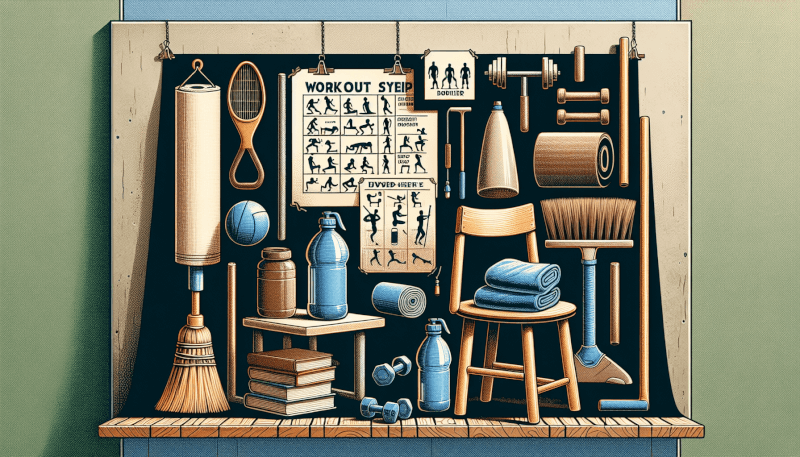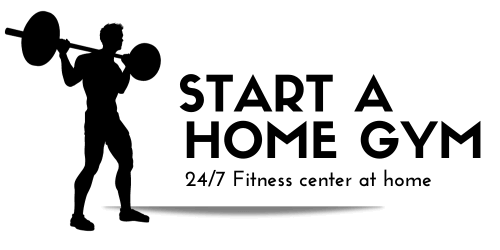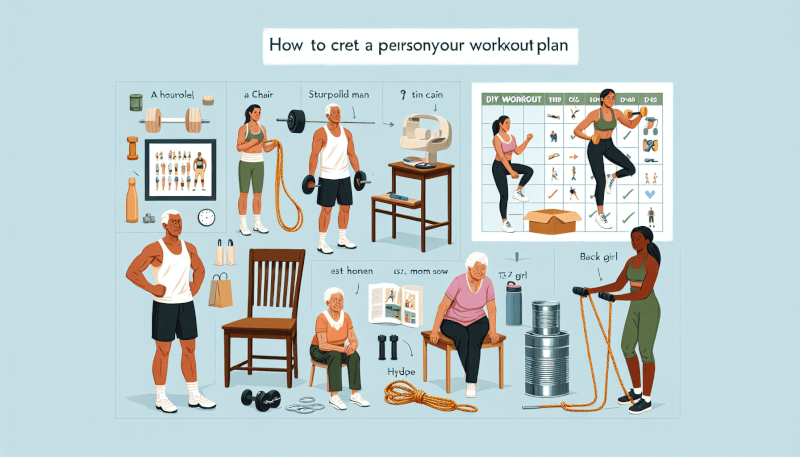Are you tired of expensive gym memberships or simply prefer to exercise in the comfort of your own home? Look no further! In this article, we’ll show you how to create your very own DIY home gym workout plan. With just a few simple steps, you can design a personalized fitness routine that fits your goals and schedule perfectly. From choosing the right equipment to creating a balanced workout schedule, we’ve got you covered. Get ready to sweat and achieve your fitness goals right from the convenience of your own home!

Setting Your Goals
Identify your fitness goals
Before designing your DIY home gym workout plan, it’s important to identify your fitness goals. What do you want to achieve? Is it weight loss, muscle gain, or overall improvement in fitness? By having a clear understanding of your goals, you can tailor your workout plan to specifically target those areas.
Determine your workout frequency
Next, consider how often you can realistically commit to working out. Are you able to exercise daily, multiple times a week, or only on weekends? Your workout frequency will influence the structure of your plan and the number of rest days you incorporate.
Define your workout duration
Decide how much time you can allocate for each workout session. This will depend on your schedule and personal preferences. Some individuals prefer shorter, more intense sessions, while others enjoy longer, more relaxed workouts. Whatever your choice, make sure it is sustainable and realistic for your lifestyle.
Assessing Your Space and Equipment
Evaluate your available space
Take a good look at the space you have available at home for your DIY gym. It could be a spare room, a corner in your living room, or even your backyard. Assess the layout and dimensions to ensure you have enough room to comfortably perform your exercises.
Determine your budget
Consider your budgetary constraints when deciding on your DIY gym equipment. Determine how much you are willing to invest in your home gym setup. Remember, expensive equipment is not always necessary to achieve your fitness goals. There are plenty of budget-friendly options available.
Choose essential equipment
Based on your fitness goals and available space, select the essential equipment you will need. This could include items such as dumbbells, resistance bands, exercise mat, stability ball, or a jump rope. Start with the basics and gradually add more equipment as you progress.
Designing Your Workout Routine
Plan your warm-up and cool-down routines
Begin your workout plan by incorporating warm-up and cool-down routines. These are essential for preparing your body for exercise and aiding in recovery. Include dynamic stretches, mobility exercises, and light cardio activities to warm up, and static stretches to cool down.
Select your exercises
Choose exercises that align with your fitness goals and can be performed with the equipment you have. There are numerous exercises to target different muscle groups, such as squats, lunges, push-ups, and planks. Research fitness resources or consult professionals for exercise ideas.
Create a balanced routine
A well-rounded workout routine should include exercises that target all major muscle groups. Ensure you incorporate exercises for your upper body, lower body, core, and back. A balanced routine will help you develop overall strength, prevent muscle imbalances, and reduce the risk of injury.
Consider incorporating strength training
Strength training is crucial for building muscle, increasing metabolism, and enhancing overall strength. Include exercises such as bicep curls, overhead presses, and deadlifts in your routine. Start with lighter weights and gradually increase the intensity as you become more comfortable and stronger.
Include cardiovascular exercises
Cardiovascular exercises are essential for improving cardiovascular health and burning calories. Incorporate activities like jogging, cycling, or jumping rope into your routine. Aim for at least 150 minutes of moderate-intensity cardio per week, or 75 minutes of vigorous-intensity cardio.
Incorporate flexibility and mobility exercises
Don’t forget to include flexibility and mobility exercises in your routine. These exercises improve joint range of motion, prevent stiffness, and enhance overall flexibility. Examples include yoga poses, stretching exercises, and foam rolling.
Choosing Exercises
Consult fitness resources or professionals
If you’re unsure about which exercises to include in your workout plan, consult reliable fitness resources or seek guidance from fitness professionals. They can provide you with expert advice and suggest exercises that align with your goals and capabilities.
Consider your fitness level
Choose exercises that are appropriate for your current fitness level. If you are a beginner, start with basic exercises and gradually progress to more challenging ones. Always prioritize safety and listen to your body to avoid overexertion or injury.
Select exercises that target different muscle groups
To ensure a well-rounded workout, select exercises that target different muscle groups. Include exercises for your legs, arms, back, chest, shoulders, and core. This will help you develop balanced strength and prevent muscle imbalances.
Choose exercises that you enjoy and that suit your preferences
To maintain motivation and enjoyment, select exercises that you genuinely enjoy and that suit your preferences. If you dislike running, try cycling or dancing instead. Experiment with different exercises to find what works best for you.

Organizing Your Workout Plan
Set specific workout days and times
To establish consistency, set specific workout days and times that align with your schedule. Treat these workout sessions as non-negotiable appointments with yourself. Consistency is key to achieving your fitness goals and creating a habit.
Alternate between muscle groups
To allow for proper recovery, alternate between muscle groups on different days. For example, focus on upper body exercises one day, lower body exercises the next, and core exercises on another day. This will prevent overworking specific muscle groups and promote balanced strength development.
Gradually increase intensity and difficulty
As you progress in your fitness journey, gradually increase the intensity and difficulty of your workouts. This could mean increasing the weight lifted, the number of repetitions, or the duration of your cardio sessions. Challenge yourself while still listening to your body’s limits.
Plan for rest and recovery days
Rest and recovery days are crucial for allowing your body to repair and become stronger. Avoid overtraining by incorporating regular rest days into your workout plan. Use these days to engage in light physical activity, stretch, or simply relax.
Tracking Your Progress
Establish measurable goals
Set specific, measurable goals to track your progress. Whether it’s losing a certain amount of weight, completing a set number of repetitions, or improving your cardiovascular endurance, having tangible goals will help you stay motivated and focused.
Use tracking methods or apps
Utilize tracking methods or apps to monitor your progress. Fitness apps can help you log your workouts, track your nutrition, and even provide personalized workout plans. Use them to measure your improvements, track your consistency, and stay accountable.
Take regular measurements
Take regular measurements to assess your progress. This could include body weight, body measurements, or even progress photos. Remember that progress isn’t solely reflected on the scale. Take into account changes in strength, endurance, and overall well-being.
Review and adjust your workout plan
Periodically review your workout plan and make necessary adjustments. As you progress, your body will adapt to certain exercises, and you may need to switch things up to continue challenging yourself. Consult fitness resources, professionals, or try new classes or programs to keep your workouts fresh and exciting.
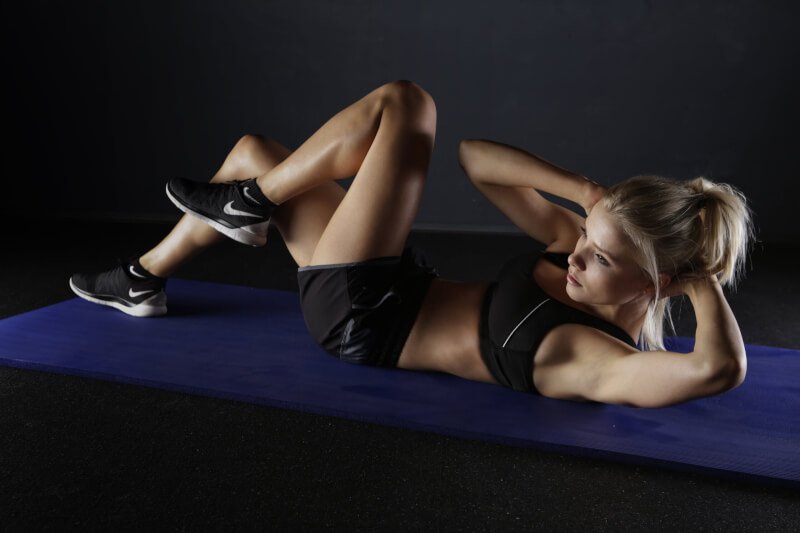
Maintaining Motivation
Find a workout buddy or accountability partner
Working out with a friend or having an accountability partner can significantly boost motivation. They can provide support, encouragement, and hold you accountable to your workout plan. Plus, exercising with someone else can make workouts more enjoyable and social.
Set rewards for achieving milestones
Set up rewards for yourself as you achieve milestones in your fitness journey. It could be treating yourself to a new workout outfit, a spa day, or a special indulgence. Celebrating your accomplishments will help you stay motivated and enjoy the process.
Switch up your routine
Prevent boredom and maintain motivation by switching up your workout routine regularly. Try new exercises, explore different fitness classes, or incorporate outdoor activities. Variety keeps workouts interesting and challenges your body in new ways.
Celebrate your accomplishments
Don’t forget to celebrate and acknowledge your accomplishments along the way. Whether it’s reaching a weight-loss goal, increasing your strength, or completing a challenging workout, take the time to acknowledge your hard work and be proud of your achievements.
Safety and Injury Prevention
Consult with a healthcare professional
Before starting any new exercise program, it’s crucial to consult with a healthcare professional, especially if you have any pre-existing medical conditions or injuries. They can provide personalized advice and ensure that your workout plan is safe and appropriate for your specific needs.
Learn proper form and technique
Learn and practice proper form and technique for each exercise. This will maximize results and minimize the risk of injury. Consider working with a personal trainer or joining a fitness class to ensure you are performing exercises correctly.
Listen to your body
Pay attention to your body’s signals and adjust your workouts accordingly. If you feel pain, discomfort, or excessive fatigue, take a step back and rest. Pushing through pain can lead to injury and setbacks. Listen to your body’s limits and progress at a pace that feels comfortable for you.
Start slowly and progress gradually
If you’re new to exercise or returning after a break, start slowly and progress gradually. Build a strong foundation by mastering basic movements before advancing to more complex exercises or heavier weights. This approach will help prevent overexertion and reduce the risk of injury.
Make safety a priority
Safety should always be a top priority when designing your DIY workout plan. Ensure your workout area is clear from hazards, maintain proper equipment maintenance, and use appropriate safety precautions. Don’t sacrifice safety for intensity or speed.
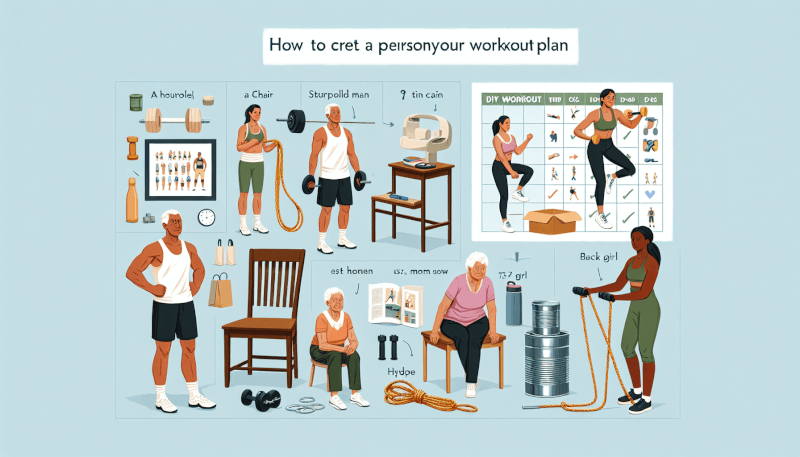
Managing Time and Space
Make use of efficient exercises
When time is limited, focus on exercises that provide the most benefits in the least amount of time. Compound exercises, such as squats, lunges, and deadlifts, target multiple muscle groups simultaneously, making them efficient choices. High-intensity interval training (HIIT) is also a great time-saving option.
Create a designated workout area
Designate a specific area in your home for your workouts. This will help create a dedicated space that is conducive to exercise and minimize distractions. Organize your necessary equipment and ensure you have enough space to move comfortably.
Optimize your workout time
Make the most of your workout time by planning ahead and being efficient. Have your equipment set up and ready to go, minimize distractions, and stay focused during your workout. Decrease rest times between sets to keep your heart rate elevated and maximize calorie burn.
Seeking Professional Advice
Consider consulting a personal trainer
If you’re unsure about how to design an effective workout plan or need guidance in reaching your fitness goals, consider working with a personal trainer. They can provide professional expertise, personalized programming, and ensure your techniques are correct.
Seek guidance from fitness experts
Fitness experts, such as exercise physiologists or sports scientists, can offer valuable advice and insights. They can provide evidence-based recommendations, help you optimize your workouts, and answer any questions you may have about your DIY home gym workout plan.
Participate in fitness classes or programs
Engaging in fitness classes or programs led by qualified instructors can provide structure, motivation, and expert guidance. Whether it’s group exercise classes, online programs, or virtual coaching, these resources can help you stay on track and ensure you’re performing exercises correctly.
Creating a DIY home gym workout plan allows you the flexibility and convenience of exercising at your own pace and in the comfort of your own space. By setting clear goals, assessing your available resources, designing a well-rounded routine, and incorporating safety measures, you can create a workout plan that aligns with your needs and helps you achieve your fitness aspirations. Remember to track your progress, stay motivated, and seek professional advice when needed. With dedication and consistency, your DIY home gym workout plan can bring you closer to your desired level of fitness.
